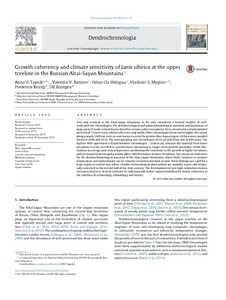Growth coherency and climate sensitivity of Larix sibirica at the upper treeline in the Russian Altai-Sayan Mountains
URI (для ссылок/цитирований):
https://elib.sfu-kras.ru/handle/2311/33180Автор:
Taynik, A. V.
Barinov, V. V.
Oidupaa, Orlan Ch.
Myglan, V. S.
Reinig, Frederick
Ulf, Büntgen
Коллективный автор:
Гуманитарный институт
Лаборатория Естественнонаучных методов в археологии и истории
Научно-исследовательская часть
Дата:
2016-09Журнал:
DendrochronologiaКвартиль журнала в Scopus:
Q1Квартиль журнала в Web of Science:
Q1Библиографическое описание:
Taynik, A. V. Growth coherency and climate sensitivity of Larix sibirica at the upper treeline in the Russian Altai-Sayan Mountains [Текст] / A. V. Taynik, V. V. Barinov, Orlan Ch. Oidupaa, V. S. Myglan, Frederick Reinig, Büntgen Ulf // Dendrochronologia. — 2016. — № 39. — С. 10-16Текст статьи не публикуется в открытом доступе в соответствии с политикой журнала.
Аннотация:
Tree-ring research in the Altai-Sayan Mountains so far only considered a limited number of wellreplicated
site chronologies. The dendroecological and palaeoclimatological potential and limitations of
large parts of south-central Russia therefore remain rather unexplored. Here, we present a newly updated
network of 13 larch (Larix sibirica Ldb.) tree-ring width (TRW) chronologies from mid to higher elevations
along a nearly 1000 km west-to-easttransect across the greater Altai-Sayan region. All data were sampled
between 2009 and 2014. The corresponding site chronologies cover periods from 440 to 860 years. The
highest TRW agreement is found between chronologies ≥2200 m asl, whereas the material from lower
elevations reveals overall less synchronized interannual to longer-term growth variability. While fluctuations
in average June–July temperature predominantly contribute to the growth at higher elevations,
arid air masses from Mongolia mainly affect TRW formation atlower elevations. Our results are indicative
for the dendroclimatological potential of the Altai-Sayan Mountains, where both, variation in summer
temperature and hydroclimate can be robustly reconstructed back in time. These findings are valid for a
huge region in central Asia where reliable meteorological observations are spatially scarce and temporally
restricted to the second half of the 20th century. The development of new high-resolution climate
reconstruction over several centuries to millennia will further appear beneficial for timely endeavors at
the interface of archaeology, climatology and history.

